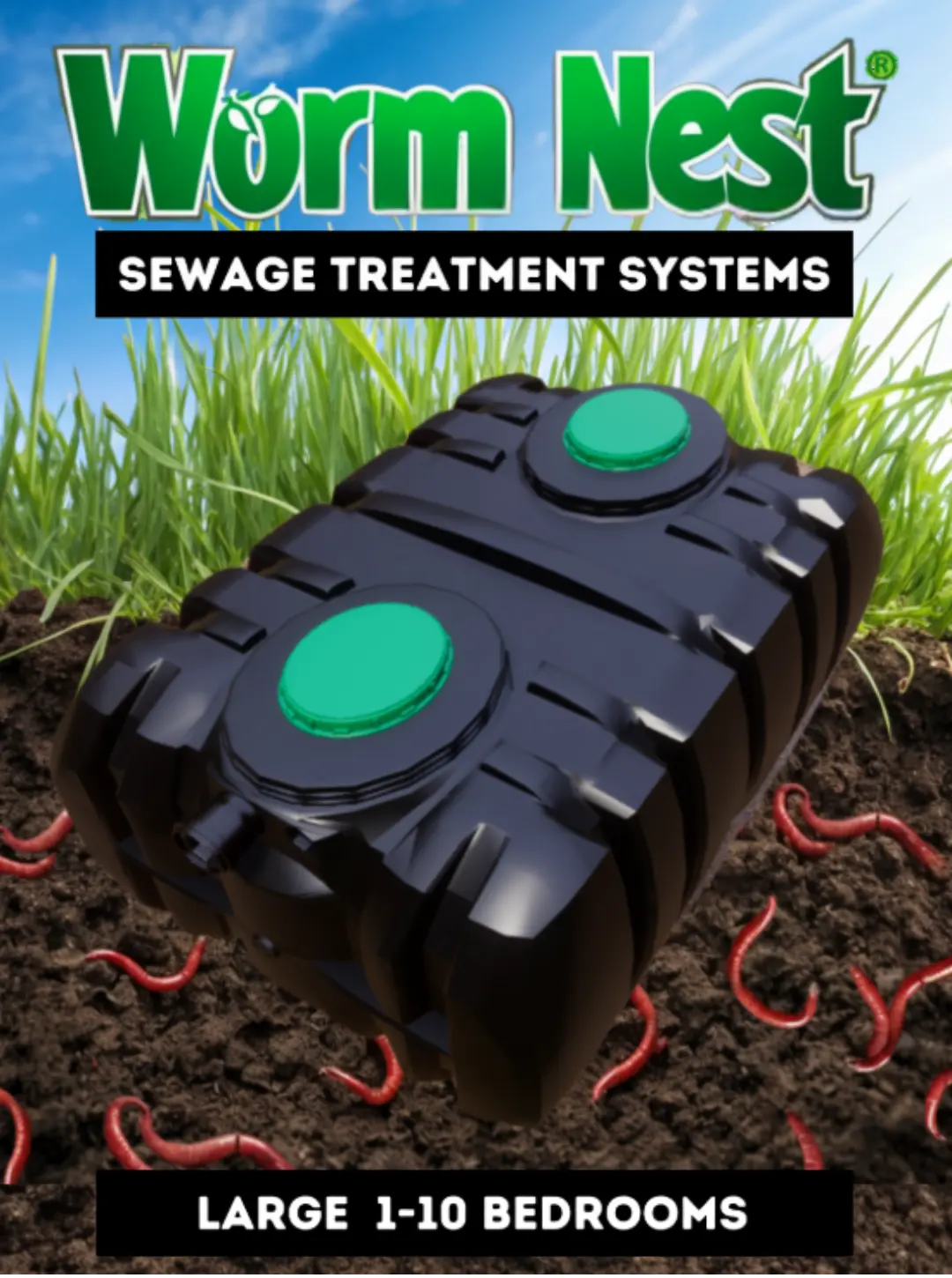Sewage Treatment Plants: A Comprehensive Guide for UK Homeowners
Abstract
Sewage treatment plants are critical for managing wastewater in UK properties not connected to mains sewer systems, particularly in rural areas. These systems treat domestic sewage to produce environmentally safe effluent, adhering to stringent regulations like the Environment Agency’s General Binding Rules. This white paper explores the science, types, operational mechanisms, regulatory framework, environmental impacts, and technological advancements of sewage treatment plants, with a case study highlighting their practical application. Optimized for the keywords “sewage treatment plant” and “sewage treatment plants,” this article aims to inform homeowners, developers, and policymakers while enhancing the online visibility of Builders Yard UK.
1. Introduction
Urban and rural landscapes in the UK face significant wastewater management challenges, with approximately 5% of homes—over 1.5 million properties—lacking access to mains sewer systems (EasyMerchant). Sewage treatment plants offer a modern solution, treating wastewater to a high standard, unlike traditional septic tanks, which are limited by environmental regulations. These systems are vital for preventing water pollution, protecting public health, and supporting sustainable development, aligning with the UK’s environmental goals.
Sewage treatment plants differ from septic tanks by employing mechanical and biological processes to produce cleaner effluent, often suitable for direct discharge into watercourses. Since 2020, regulations have restricted septic tank discharges to watercourses, making sewage treatment plants the preferred choice for compliance (GOV.UK). This article provides a detailed examination of sewage treatment plants, their operation, regulatory requirements, and environmental benefits, supported by a case study. For expert solutions, visit Sewage Treatment Plant UK or Sewage Treatment Plants UK.
2. Understanding Sewage Treatment Plants
2.1 What is a Sewage Treatment Plant?
A sewage treatment plant is an advanced wastewater treatment system that processes domestic sewage from toilets, sinks, baths, and appliances. It uses physical, biological, and sometimes chemical processes to remove contaminants, producing effluent that is typically 95% clean, safe for discharge into watercourses or drainage fields (CSG). Unlike septic tanks, which rely on anaerobic digestion and require soakaways, sewage treatment plants actively treat wastewater, making them suitable for diverse UK sites.
2.2 Sewage Treatment Plants vs. Septic Tanks
| Feature | Sewage Treatment Plant | Septic Tank |
|---|---|---|
| Treatment Process | Mechanical and biological, producing clean effluent | Basic settling, anaerobic digestion |
| Discharge | Can discharge to watercourses with consent | Requires soakaway or drainage field |
| Maintenance | Regular servicing, electricity needed | Less frequent, no electricity |
| Environmental Impact | Minimal with proper maintenance | Higher risk of pollution if non-compliant |
| Regulatory Compliance | Meets 2020 regulations for watercourse discharge | Restricted post-2020 for watercourse discharge |
Sewage treatment plants are increasingly favored due to their compliance with modern environmental standards (UKDP Solutions).
2.3 Importance in the UK
The UK’s rural communities rely on off-mains solutions to manage wastewater. Sewage treatment plants reduce pollutants like phosphorus and ammonia, which have decreased by 67% and 79% respectively since 1995, improving river ecosystems (Water UK). They support biodiversity, enabling species like salmon and otters to thrive in previously polluted rivers. For reliable systems, explore Builders Yard UK.
3. Types of Sewage Treatment Plants in the UK
Several types of sewage treatment plants are used in the UK, each suited to specific applications:
3.1 Package Treatment Plants
These compact systems, like the Tricel Novo, use submerged aerated filter (SAF) technology to treat wastewater for small populations (1–50 people). They are ideal for single homes or small communities, offering low maintenance and high efficiency (Tricel UK).
3.2 Rotating Biological Contactors (RBC)
RBC systems, such as the Klargester BioDisc, feature rotating discs that support bacterial growth, breaking down organic matter. They are reliable for domestic use but require electricity and regular servicing (The Sewage Guy).
3.3 Activated Sludge Systems
Common in larger installations, these systems use aeration to promote bacterial activity, treating wastewater in a suspended growth process. They are less common for domestic use due to higher costs and space requirements (Membracon).
3.4 Non-Electric Systems
Innovative systems like BIOROCK use media-based filtration without electricity, ideal for eco-conscious homeowners. They require minimal maintenance but may have higher upfront costs (BIOROCK).
Table 2: Comparison of Sewage Treatment Plant Types
| Type | Population Served | Power Requirement | Maintenance Frequency | Cost |
|---|---|---|---|---|
| Package Treatment | 1–50 | Yes | Annual | Moderate |
| RBC | 1–20 | Yes | Annual | Moderate-High |
| Activated Sludge | 20+ | Yes | Frequent | High |
| Non-Electric | 1–30 | No | Low | Moderate-High |
For a range of options, visit Sewage Treatment Plants UK.
4. How Sewage Treatment Plants Work
4.1 Primary Settlement
Wastewater enters the primary chamber, where solids settle as sludge, and grease and oils float as scum. This physical separation reduces the organic load (Pumping Solutions).
4.2 Aeration (Secondary Treatment)
The liquid effluent flows into an aeration chamber, where air pumps or rotating discs introduce oxygen, fostering aerobic bacteria growth. These bacteria degrade organic matter, reducing biochemical oxygen demand (BOD) and suspended solids (Drainage Superstore).
4.3 Final Settlement
In the final chamber, remaining solids settle out, forming humus sludge. The clarified effluent, often 95% clean, is discharged, subject to Environment Agency consent (CSG).
4.4 Tertiary Treatment (Optional)
Some plants include tertiary stages, such as UV disinfection or nutrient removal, to meet stringent discharge standards, especially for sensitive water bodies (Membracon).
Diagram Placeholder: A schematic of a sewage treatment plant showing primary, aeration, and final chambers would enhance understanding.
5. Regulations and Standards in the UK
5.1 General Binding Rules
The Environment Agency’s General Binding Rules, updated in 2023, govern small sewage discharges. Key requirements include:
- Discharge Limits: Effluent must meet standards (e.g., 20:30:20 for BOD, suspended solids, and ammonia).
- Consent to Discharge: Required for discharges to watercourses exceeding 5,000 liters/day.
- Maintenance: Systems must be serviced annually to prevent pollution (GOV.UK).
5.2 EN 12566-3 2005 Certification
All sewage treatment plants must be certified to EN 12566-3 2005, ensuring structural integrity, treatment efficiency, and compliance with UK building regulations (WTE).
5.3 Planning Permission
Installation may require planning permission, especially for new builds or sensitive sites. Homeowners should consult local authorities (Proseptic).
5.4 2020 Regulatory Changes
Post-2020, septic tanks discharging to watercourses are non-compliant, necessitating upgrades to sewage treatment plants (Tricel UK). For compliance guidance, visit Sewage Treatment Plant UK.
6. Case Study: Tricel Novo UK 18 Installation in Devon
In September 2021, a homeowner in Devon needed to replace an outdated septic tank discharging to a watercourse, non-compliant with 2020 regulations. Tricel UK supplied a Novo UK 18 sewage treatment plant, designed for up to 18 people, using SAF technology (Tricel UK).
6.1 Situation
The property, a large rural home, lacked mains sewer access. The existing septic tank polluted a nearby stream, risking fines from the Environment Agency.
6.2 Installation Process
- Site Assessment: Conducted to confirm soil conditions and discharge options.
- Consent to Discharge: Obtained from the Environment Agency.
- Installation: Completed in two days, with minimal disruption due to the lightweight SMC tank design.
- Commissioning: Ensured the plant met BOD standards (11:16:9 vs. required 20:30:20).
6.3 Outcomes
- Compliance: Met 2020 regulations, avoiding penalties.
- Environmental Benefit: Reduced stream pollution, supporting local biodiversity.
- Efficiency: Low maintenance and energy costs.
This case mirrors services offered by Builders Yard UK.
7. Environmental Impact of Sewage Treatment Plants
7.1 Positive Impacts
- Pollution Reduction: Treated effluent prevents contamination of watercourses, protecting aquatic life (OMDI).
- Water Quality Improvement: Reduced phosphorus and ammonia levels enhance river ecosystems (Water UK).
- Biodiversity Support: Cleaner water supports species like otters and salmon.
7.2 Potential Negative Impacts
- Energy Consumption: A typical 6-person plant consumes ~438 kWh annually, contributing to carbon emissions if powered by non-renewable sources (Harlequin Plastics).
- Sludge Disposal: Improper disposal can harm soil or water quality.
- Chemical Risks: Harsh chemicals can disrupt bacterial processes, requiring careful household practices (WCS Group).
Proper maintenance mitigates these risks, ensuring net environmental benefits.
8. Technological Advances in Sewage Treatment Plants
8.1 Non-Electric Systems
BIOROCK systems use media-based filtration, eliminating electricity needs and reducing carbon footprints (BIOROCK).
8.2 Reed Bed Integration
Ecological reed beds filter effluent naturally, enhancing sustainability (Centre for Alternative Technology).
8.3 Smart Monitoring
IoT and AI enable real-time monitoring, optimizing performance and reducing maintenance costs (ScienceDirect).
8.4 Energy-Efficient Designs
Plants like the Solido Smart minimize energy use and noise, ideal for domestic settings (The Sewage Guy).
For innovative solutions, explore Sewage Treatment Plants UK.
9. Conclusion
Sewage treatment plants are essential for sustainable wastewater management in the UK, offering superior treatment compared to septic tanks. By adhering to regulations, leveraging advanced technologies, and ensuring proper maintenance, homeowners can protect the environment and comply with legal standards. As innovations continue, these systems will play a growing role in achieving sustainability goals. For tailored solutions, contact Builders Yard UK or visit Sewage Treatment Plant UK.
References
- Environment Agency. (2021). General Binding Rules for Septic Tanks and Small Sewage Treatment Plants. GOV.UK.
- Tricel UK. (2023). Types of Sewage Treatment Plants. Tricel UK.
- CSG. (2017). How Do Sewage Treatment Plants Work?. CSG.
- Membracon. (2022). What is a Sewage Treatment Plant & How Does It Work?. Membracon.
- EasyMerchant. (2022). A Guide to Domestic Sewage Treatment Plants. EasyMerchant.
- Water UK. (n.d.). Sewage Treatment Works. Water UK.
- OMDI. (2021). How Sewage Treatment Plants Help the Environment. OMDI.
- BIOROCK. (2012). Residential & Commercial Wastewater Treatment. BIOROCK.
- ScienceDirect. (2022). Role of Wastewater Treatment in SDGs. ScienceDirect.
- Centre for Alternative Technology. (2018). Sewage Treatment. CAT.


